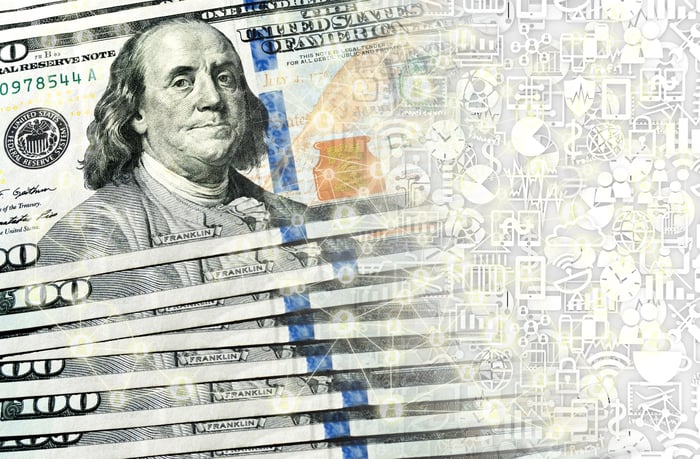Over the long run, investing in the stock market has been one of the most-effective ways to build wealth and achieve financial independence. Even though stocks don't outpace bonds and commodities every year, they've handily trumped bonds and commodities in terms of average annual gain over multiple decades.
But in the short-term, cryptocurrencies have absolutely run circles around Wall Street. Whereas the benchmark S&P 500 has more than doubled since hitting its pandemic low in March 2020, the market value of all cryptocurrencies has almost grown 20-fold, from $141 billion to $2.74 trillion, over the same stretch.

Image source: Getty Images.
Crypto investors can't get enough of this trio
Leading the charge, at least in terms of internet search buzz, are Bitcoin (BTC -3.47%), Ethereum (ETH -2.27%), and Shiba Inu (SHIB -1.49%). According to Bacancy Technology, these are the three most-searched cryptocurrencies on Google, a subsidiary of Alphabet, in 2021.
Bitcoin has had a banner year in that it's hit an all-time high and was anointed by El Salvador as legal tender. This milestone paves the way for other countries to potentially lessen cryptocurrency regulations on Bitcoin, or potentially even legalize it like El Salvador.
The buzz surrounding Ethereum has everything to do with its role as the backbone of decentralized finance (DeFi). DeFi involves the use of smart contracts on financially focused blockchain to complete payments without the need for financial institutions. Utilizing DeFi means avoiding the payment slowdowns or halts that might accompany bank-initiated payments.
And then there's the ultra-popular meme coin Shiba Inu, which gained as much as 17,300,000% in 15 months. Everything from the launch of decentralized exchange ShibaSwap to regular tweets from Tesla Motors CEO Elon Musk about his Shiba Inu-breed dog have sent SHIB tokens skyward.

Image source: Getty Images.
One number shows why Cardano and Solana are far more intriguing
But for all the buzz this trio of popular coins has created, it doesn't hold a candle to the excitement Cardano (ADA -1.45%) and Solana (SOL -2.72%) bring to the table.
To be fair, Cardano and Solana aren't exactly under-the-radar slouches. Cardano is up a little over 1,000% on a year-to-date basis, through Nov. 6, whereas Solana's year-to-date gains are approaching 16,800%. Eye-popping increases in token price tend to draw attention in the cryptocurrency space. However, it's not their year-to-date performance that makes these coins exciting. It's the scalability of their blockchain networks, as measured by transactions per second (TPS).
Bitcoin may be the most valuable cryptocurrency by a mile, but its processing capacity is particularly slow. The most-searched digital currency can only handle around seven transactions per second.
Ethereum isn't much better. Its blockchain network is only handling 13 transactions per second, with these speeds prone to slowdowns during periods of congestion. Since Shiba Inu is an ERC-20 token based on the Ethereum blockchain, it's also tethered to a transactional ceiling of 13 TPS.
By comparison, Cardano was tested at roughly 250 TPS four years ago, but this looks to be just the tip of the iceberg. The upcoming Hydra upgrade is a layer-two solution designed to improve the scalability of Cardano's rapidly growing network. It does this by processing transactions off-chain while still utilizing the main-chain ledger for settlements. This can significantly reduce transaction cost and rapidly improve processing time. Hypothetical figures as high as 1,000,000 TPS have been thrown around with this upgrade. For some context, payment processing giant Visa peaks at 24,000 TPS.
As for Solana, it's capable of processing at 50,000 TPS. Solana's proof-of-history protocol creates a record of an event happening between specific times, rather than relying on validators to talk to each other and assess the time that's passed between events. This expedites transactions and scales Solana's blockchain network to blazing speeds. According to Solana's whitepaper, an estimated 710,000 TPS is believed possible with today's hardware.

Image source: Getty Images.
There's real-world potential here... with a catch
The ultimate goal for blockchain technology is to provide faster transactions at a fraction of today's cost, all while democratizing the process to include folks who might otherwise be excluded from basic banking services. What Cardano and Solana offer can do just that, and so much more (both are at the heart of decentralized applications). While both blockchain networks are still relatively early in the trial-and-error/scaling stage of their development, the groundwork is laid for a possible alternative to existing payment infrastructure.
But there's a catch.
Existing payment infrastructure is known and time-tested. For businesses to make the costly and time-consuming switch to blockchain, the technology will need to demonstrate its ability to scale in the real world without compromising security. While we've witnessed some early stage success stories, we've not yet seen broad-based blockchain adoption in the real word. It's something of a Catch-22: Businesses won't make the leap until the technology demonstrates broad-based scalability, yet no evidence of broad-based scalability will be seen until businesses give blockchain technology a trial run.
Another thing to be mindful of is the fact that investors have a habit of overestimating the adoption of new technology. Dating back more than a quarter of a century, bubbles were observed with the advent of internet, business-to-business commerce, genomics, marijuana, 3D printing, and so on. This isn't to say that blockchain technology won't become a mainstream part of our lives at some point in the future. Rather, it's to point out that investor optimism seemingly always front-runs the capability and/or adoption of new technology or products.
As a crypto skeptic, I find the solutions Cardano and Solana are cooking up very exciting. But at the same time, I'm also keenly aware of the early stage track record of next-big-thing investments.




